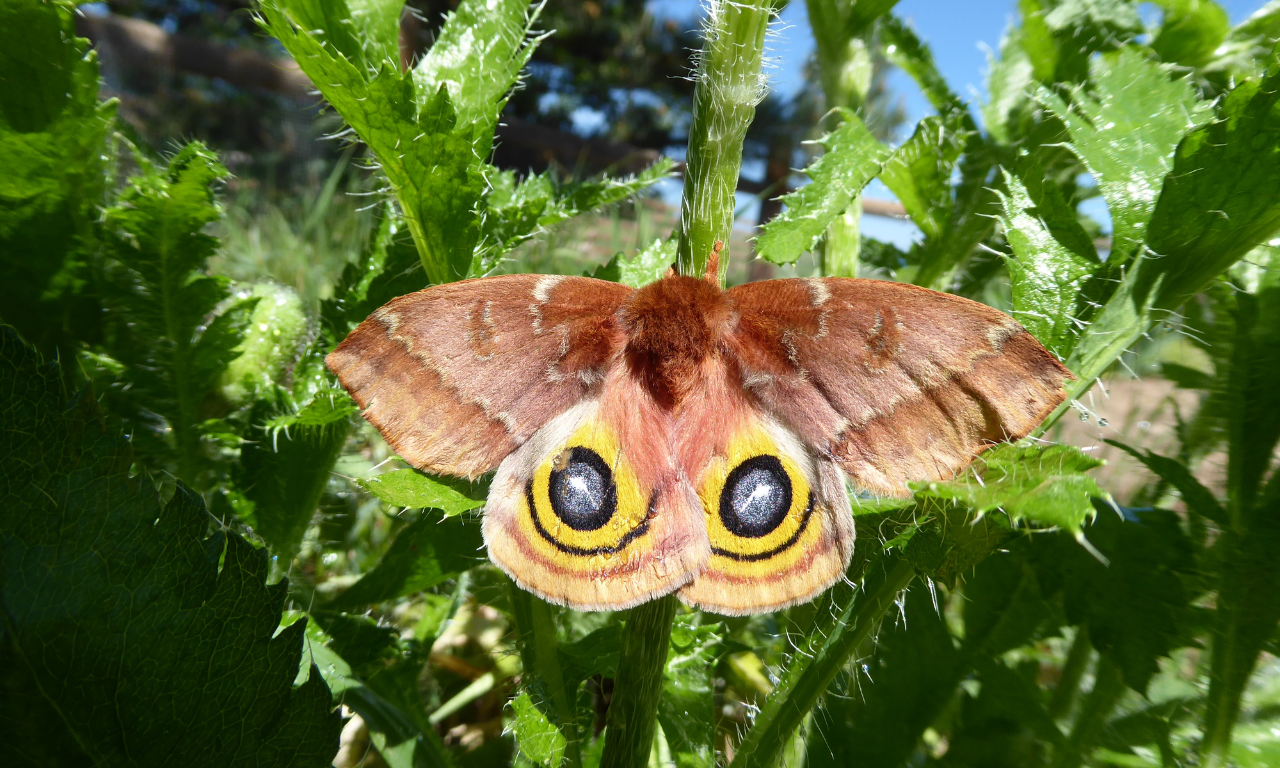Butterflies are easy to admire and love. They are brightly colored, harmless, fly by day, and catch the eye as they flit from flower to flower. Lovely! But moths? Aren’t they mostly drab night fliers that flutter around campfire lights, get in your face as you sit outdoors, and come indoors to devour your stored wool sweaters? Staying close to home during the pandemic, enjoying small local wildlife changed my thinking about moths and spawned a new hobby—or mania— I call it “mothing.”
Moths and butterflies belong in the same insect ‘Order’—Lepidoptera—which means “scaled wings.” The scales are modified hairs and are responsible for insects’ coloration through pigments and reflective structures. Adults of all moths (and butterflies, as well) have the typical insect body parts: paired feelers (antennae) and straw-like feeding tubes (proboscises) on the head that curl up when not in use; two pairs of scale-covered wings and three pairs of legs on the thorax (mid-section); and long, fleshy abdomens.
All lepidopterans follow similar life cycles. Eggs hatch into tiny caterpillars (eating machines) that grow and shed through several stages (instars) until they are ready to pupate. They shed their tight casings (exoskeletons) each time they have a growth spurt—think kids outgrowing tight T-shirts! Finally, they hatch from the pupae as flying adults, the final, finished product. Butterflies and moths are not always easy to tell apart.
Field clues can be iffy. Take these suggestions with the proverbial grain of salt! Worldwide, there are roughly 10 times more kinds of moths than there are butterflies, and no doubt many more to discover. It would be a tragic loss for species to disappear before we even know of their existence.
Thousands of moth species live in Colorado, from huge to microscopic. A black witch’s wingspan can be greater than 6-inches. Many so-called “micromoths” are measured in mere millimeters. Some moths are brightly colored. Others are drab. Most fly by night, but others fly by day. Many are important plant pollinators. Several species are serious pests of crops and forests. Some appear densely furry. Others have see-through wings. They may hover like hummingbirds, twirl like dancers, or rest almost invisibly in their cryptic splendor. The variety among moths is mind-blowing. Many moths communicate with pheromones—chemicals released in the air and perceived by other moths. That’s how they find a mate.
A few moth species have ears sensitive to bat echolocation and react to potential bat danger by plummeting to the ground out of harm’s way. Some developed sound-making organs that can startle or warn bats away—or even jam a bat’s sonar to escape becoming prey.
One way to find night-flying moths is to look around lights, especially those having UV wavelengths. (The trait of light seeking is called positive phototaxis.) Why do moths come to lights? There is no generally accepted theory, and not all night-flying moths come to lights anyway. We just notice those that do.
Are moths attracted to the moon as a means of orientation, (anticipating that light means up, dark means ground), and mistake random lights for the moon up in the sky? Is heading upwards (moonward) a tactic to avoid predation as moths migrate? Do moths use the moon and stars in navigation by keeping the light at a constant angle to the eye to keep on track . . . and mistakenly use the same tactic in homing in on random lights? (This might cause a spiraling path in toward a lamp—or lethally, an open flame.) The jury is still out on the exact “why” of light attraction, but it is worth noting that lights are less effective in attracting moths on full moon nights.
Regardless of why moths fly toward light, it’s evident that those bright gas stations, all night diners, security-lit office complexes, brightly lit homes, ball fields, and the like may well disrupt the normal lives of moths going about moth tasks of eating, pollinating, and mating. It is also evident that there’s much to learn about moths and their lives, and citizen science can be a part of it.
Moths vs Butterflies
| Moths | Butterflies |
|---|---|
| Fuzzy or feathery antennae | Clubbed or hooked antennae |
| Active at night (not all) | Fly by day |
| Rest with bings flat (not all) | Rest with wings held above body, bust bask with flat wings |
| Front and hind wings hook together | Front and hinds wings are independent of one another |


